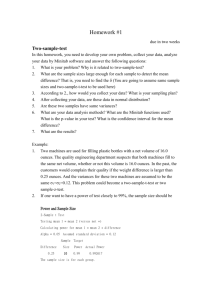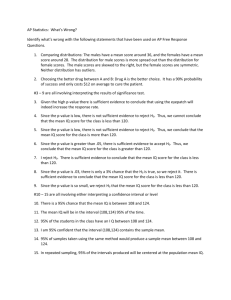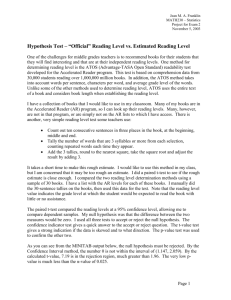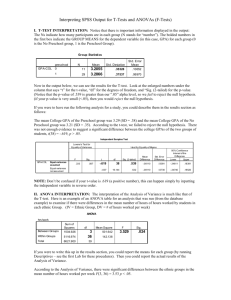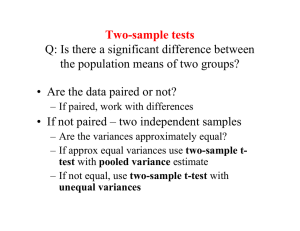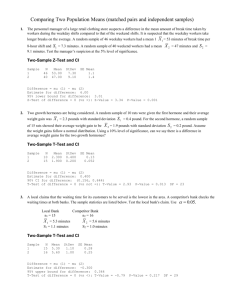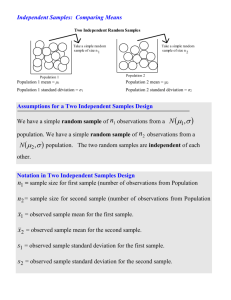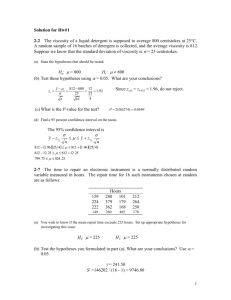Examples Performing a Hypothesis Test
advertisement
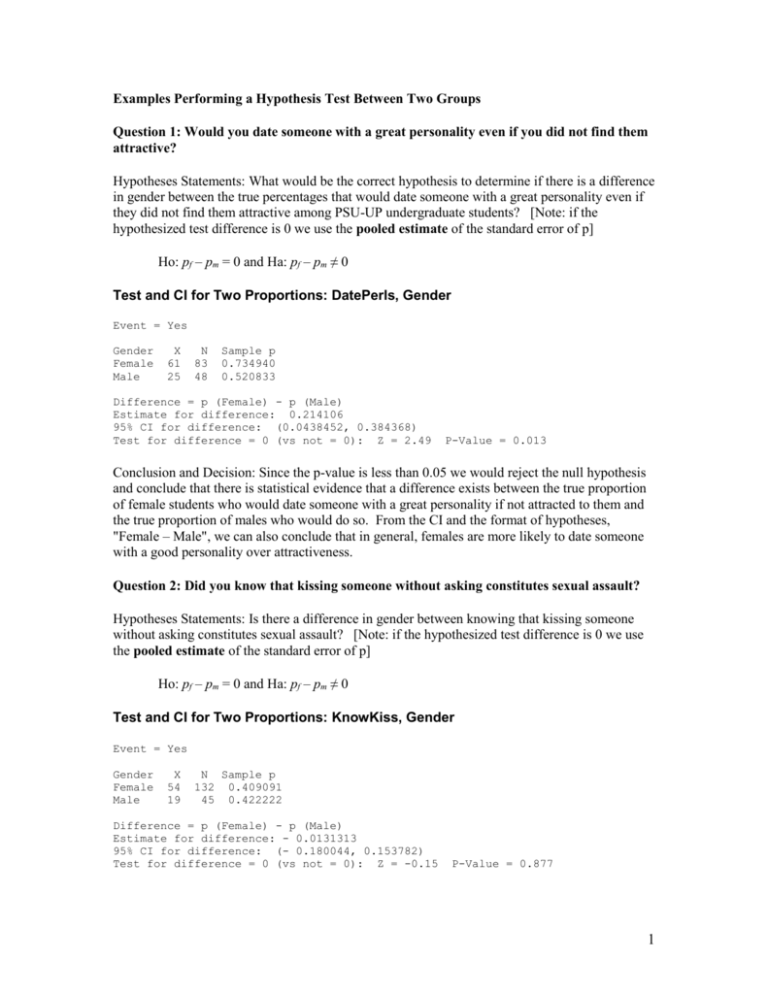
Examples Performing a Hypothesis Test Between Two Groups Question 1: Would you date someone with a great personality even if you did not find them attractive? Hypotheses Statements: What would be the correct hypothesis to determine if there is a difference in gender between the true percentages that would date someone with a great personality even if they did not find them attractive among PSU-UP undergraduate students? [Note: if the hypothesized test difference is 0 we use the pooled estimate of the standard error of p] Ho: pf – pm = 0 and Ha: pf – pm ≠ 0 Test and CI for Two Proportions: DatePerls, Gender Event = Yes Gender Female Male X 61 25 N 83 48 Sample p 0.734940 0.520833 Difference = p (Female) - p (Male) Estimate for difference: 0.214106 95% CI for difference: (0.0438452, 0.384368) Test for difference = 0 (vs not = 0): Z = 2.49 P-Value = 0.013 Conclusion and Decision: Since the p-value is less than 0.05 we would reject the null hypothesis and conclude that there is statistical evidence that a difference exists between the true proportion of female students who would date someone with a great personality if not attracted to them and the true proportion of males who would do so. From the CI and the format of hypotheses, "Female – Male", we can also conclude that in general, females are more likely to date someone with a good personality over attractiveness. Question 2: Did you know that kissing someone without asking constitutes sexual assault? Hypotheses Statements: Is there a difference in gender between knowing that kissing someone without asking constitutes sexual assault? [Note: if the hypothesized test difference is 0 we use the pooled estimate of the standard error of p] Ho: pf – pm = 0 and Ha: pf – pm ≠ 0 Test and CI for Two Proportions: KnowKiss, Gender Event = Yes Gender Female Male X 54 19 N Sample p 132 0.409091 45 0.422222 Difference = p (Female) - p (Male) Estimate for difference: - 0.0131313 95% CI for difference: (- 0.180044, 0.153782) Test for difference = 0 (vs not = 0): Z = -0.15 P-Value = 0.877 1 Conclusion and Decision: Since the p-value is greater than 0.05 we would fail to reject the null hypothesis and conclude that there is no statistical evidence to conclude a difference exists between the genders in the proportion who know that kissing without asking constitutes sexual assault. Question 2: How much are you willing to spend on a first date? Ho: uf − um = 0 and Ha: uf − um ≠ 0 Before we proceed we need to address a new concept related to the standard error. When we consider comparing two or more populations it would be helpful if we could assume that the variability of each population is the same even if the means differ. The general rule of thumb to determine equal variances for two populations is to compare the two sample standard deviations. If the ratio of the larger to the smaller is less than or equal to 2.0 we can assume the variances are equal. This looks like the following: S larger Ssmaller 2.0 Using descriptive statistics, the larger S is 69.9 (male) and 18.5 (female) is the smaller. The ratio then is 69.9/18.5 > 2.0 thus we can assume the variances for the female and male populations are NOT equal. With the variances assumed equal, we use the unpooled method in calculating our standard error. S.E.(unpooled) = S +S 2 2 1 2 N1 N2 2 = 69.9 + 18.5 45 131 2 =10.54 If the variances are assumed equal, we use: S.E.(pooled) = S p 1 1 where Sp = N1 N 2 ( N1 1) * S12 ( N 2 1) * S22 N1 N 2 2 A 95% confidence interval for the true difference would equal: (X-barf -X-barm) +/- 1.96*2.64 = (42.8 – 51.9) +/- 2*10.54 = -9.1 +/- 21.08 = -30.18, 11.98 Two-Sample T-Test and CI: DateSpnd, Gender Two-sample T for DateSpnd Gender female male N 131 45 Mean 42.8 51.9 StDev 18.5 69.9 SE Mean 1.6 10 Difference = mu (female) - mu (male) Estimate for difference: -9.0 95% CI for difference: (-30.3, 12.2) T-Test of difference = 0 (vs not =): T-Value = -0.86 P-Value = 0.396 DF = 46 2 Conclusion and Decision: Since the p-value is greater than 0.05 we would fail to reject the null hypothesis and conclude that there is no difference between the genders in the mean amount of money spent on a date. Also, since we the confidence interval for the mean difference includes zero, this would further support our decision to not conclude a difference in means exist. Question 4: Is there a difference in car estimates between two repair shops? We could either treat the samples as two independent samples and conduct a two-mean test, OR we can conduct a test that compares across the shops i.e. compares the estimates of the two shops on the same car. Ho: u1 – u2 = 0 and Ha: u1 – u2 ≠ 0 Two-Sample T-Test and CI: One, Two Two-sample T for One vs Two Pre_87 No Yes N 15 15 Mean 16.83 16.23 StDev 3.22 2.94 SE Mean 0.83 0.76 Difference = mu (One) - mu (Two) Estimate for difference: 0.59 95% CI for difference: (-1.71, 2.90) T-Test of difference = 0 (vs not =): T-Value = 0.53 P-Value = 0.602 DF = 28 Both use Pooled StDev = 3.0830 NOTE- See if you can calculate this value by hand using the steps outlined in Question 2 With p-value 0.602 we would fail to reject Ho and conclude that there is no difference in mean repair costs between the two shops. Also, with the 95% CI including zero this would further support that there is no difference in average repair estimates between the two shops. Ho: ud = 0 and Ha: ud ≠ 0 where the difference is found by taking Shop One estimates minus Shop Two estimates Paired T-Test and CI: One, Two Paired T for One - Two One Two Difference N 15 15 15 Mean StDev SE Mean 16.827 3.219 0.831 16.233 2.941 0.759 0.593 0.403 0.104 95% CI for mean difference: (0.370, 0.816) T-Test of mean difference = 0 (vs not = 0): T-Value = 5.71 P-Value = 0.000 With p-value 0.000 we would reject Ho and conclude that there is a difference in mean repair costs between the two shops. Also, with the 95% CI being positive and the difference found by taking the One minus Two, we conclude that on average Shop One charges statistically significantly more for estimates than Shop Two. 3
